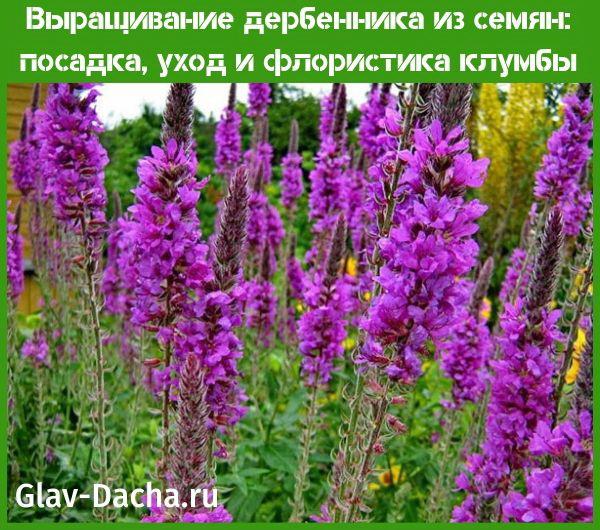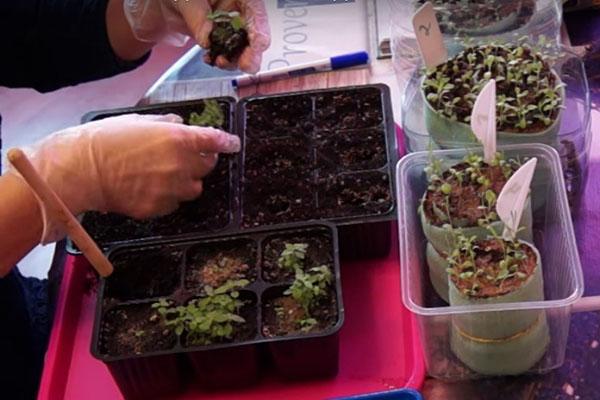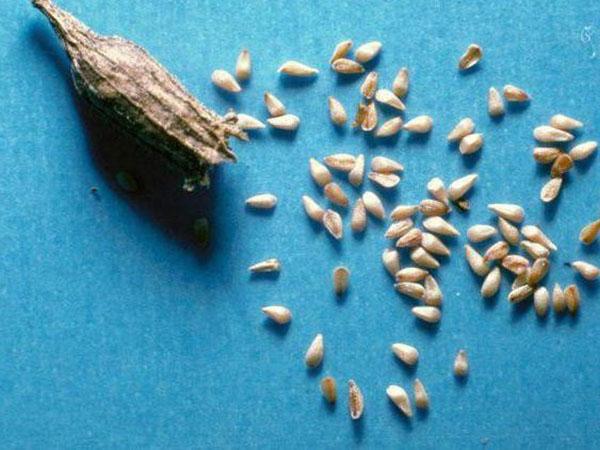Growing loosestrife from seeds: planting, care and floristry of flower beds
 Luxurious flower arrangements are a worthy decoration for any garden. Therefore, the cultivation of loosestrife from seeds takes an important place in the life of every grower. This perennial crop is capable of growing in a wide variety of extreme conditions. Yet, without sufficient lighting, the plant loses all its attractiveness. The ideal place for its growth is pond, because in nature, plakun-grass (popular name) often grows along water bodies.
Luxurious flower arrangements are a worthy decoration for any garden. Therefore, the cultivation of loosestrife from seeds takes an important place in the life of every grower. This perennial crop is capable of growing in a wide variety of extreme conditions. Yet, without sufficient lighting, the plant loses all its attractiveness. The ideal place for its growth is pond, because in nature, plakun-grass (popular name) often grows along water bodies. 
Growing a loosestrife from seed is a matter of meticulous precision
 Planting an amazing plant in open ground is planned in early spring, as soon as the snow melts from the beds. You can also do this in mid-autumn (October), when the weather begins to change dramatically. For him, clay or swampy flower beds are selected.
Planting an amazing plant in open ground is planned in early spring, as soon as the snow melts from the beds. You can also do this in mid-autumn (October), when the weather begins to change dramatically. For him, clay or swampy flower beds are selected.
However, weeping grass does not tolerate these types of soils:
- heavy;
- alkaline;
- free flowing.
At the same time, the culture is propagated in several ways. In addition to dividing the bush and root cuttings, gardeners prefer to cultivate loosestrife from seeds.
In late February or early March, planting material is planted for seedlings. Features of this procedure:
- prepare loose, fertile soil;
- seeds are laid out on the surface of the soil;
- sprinkle them with earth;
- generously sprayed from a spray bottle;
- cover with glass or film;
- germinate at a temperature of 15-18˚С.
The seedlings should be aired for 15 minutes daily to prevent mold. If necessary, the planted seeds are watered.
 Subject to the listed rules of planting and caring for the loosestrife, the first shoots should appear in 3-4 weeks. If this does not happen at the appointed time, then the seeds are subjected to additional stratification... The container is sent to a cool room (± 4˚С) for 14-21 days. When 3-4 full-fledged leaves appear, the seedlings are picked into separate containers.
Subject to the listed rules of planting and caring for the loosestrife, the first shoots should appear in 3-4 weeks. If this does not happen at the appointed time, then the seeds are subjected to additional stratification... The container is sent to a cool room (± 4˚С) for 14-21 days. When 3-4 full-fledged leaves appear, the seedlings are picked into separate containers.
Do not expect that in the year of planting, the loosestrife will immediately begin to bloom. The first buds on its spikelets will appear 2-3 years after sowing.
 Loose grass seedlings are planted on the flowerbed in March, when the threat of repeated frosts passes. In this case, it is worth adhering to the agricultural technology of planting a crop. The distance between the specimens should be 30-40 cm.If the plant is propagated by dividing the bushes, then the interval between the seedlings is increased to 50 cm.
Loose grass seedlings are planted on the flowerbed in March, when the threat of repeated frosts passes. In this case, it is worth adhering to the agricultural technology of planting a crop. The distance between the specimens should be 30-40 cm.If the plant is propagated by dividing the bushes, then the interval between the seedlings is increased to 50 cm.
Caring for an extraordinarily hardy loosestrife
 High soil moisture is the main requirement for growing crops. When these conditions are not met, the plant begins to suffer from moisture deficiency. In such cases, weeping grass requires regular, but at the same time, abundant watering. If the flowers grow near a reservoir or in shallow water, then they will not need additional irrigation.
High soil moisture is the main requirement for growing crops. When these conditions are not met, the plant begins to suffer from moisture deficiency. In such cases, weeping grass requires regular, but at the same time, abundant watering. If the flowers grow near a reservoir or in shallow water, then they will not need additional irrigation.
Planting and caring for the willow bush also includes mulching the soil in spring. For this, gardeners use compost or high-moor peat. Such a nutritious cover is able to retain moisture in the soil for a long time.
Although plakun-grass perfectly tolerates the poor composition of the soil, farmers are still advised to additionally feed it. Of course, mulching with organic matter saturates the soil with useful substances. Nevertheless, mineral fertilizers are applied to stimulate the formation of young peduncles.
However, the planting of loosestrife often affects aphids, which are located on the stems and leaves of the culture. To combat it, gardeners use insecticides:
- Bi-58;
- Tanrek;
- Fitoverm;
- Aktara;
- Spark;
- Trichopolum;
- Aktofit.
An excess of nitrogen-containing compounds in the soil leads to lodging of loosestrife shoots.
The action of these drugs is instantaneous. Therefore, it is important to strictly follow the recommendations specified in the instructions. By taking care of his flower bed in this way, the gardener will be able to protect the entire garden from terrible bacterial and fungal diseases.
Pruning a loosestrife to create a beautiful flower bed
 Many gardeners love the natural, natural beauty and lushness of weeping grass. However, in order to form luxurious compositions, it is necessary to regularly form loosestrife bushes. Such pruning promotes the formation of thickened plantings, as well as the creation of the correct shape of the bouquets.
Many gardeners love the natural, natural beauty and lushness of weeping grass. However, in order to form luxurious compositions, it is necessary to regularly form loosestrife bushes. Such pruning promotes the formation of thickened plantings, as well as the creation of the correct shape of the bouquets.
Loosestrife Pink pearl is the most spectacular member of this family. On its paniculate, spike-shaped peduncles, lilac-pink flowers in the form of stars look luxuriously.
 Since the crop is known for its self-seeding, it is completely pruned in the fall. So that the bush does not grow, faded peduncles are removed from it. This is done before the seeds are ripe. The stems are cut almost to the very root. Some creative florists leave dry flower stalks in the flower bed, as they look harmoniously in compositions with chrysanthemums and asters. However, in the spring, the aboveground part of the plant is necessarily cut off. This promotes the formation of new shoots.
Since the crop is known for its self-seeding, it is completely pruned in the fall. So that the bush does not grow, faded peduncles are removed from it. This is done before the seeds are ripe. The stems are cut almost to the very root. Some creative florists leave dry flower stalks in the flower bed, as they look harmoniously in compositions with chrysanthemums and asters. However, in the spring, the aboveground part of the plant is necessarily cut off. This promotes the formation of new shoots.
Winter hardiness of loosestrife and its commonwealth with other plants
 Since weeping grass feels great in a humid environment, it is able to successfully endure wintering in the middle lane. For this reason, cut crop stems do not need hilling or shelter. This also applies to young seedlings. The plant perfectly adapts to the climatic conditions of many regions.
Since weeping grass feels great in a humid environment, it is able to successfully endure wintering in the middle lane. For this reason, cut crop stems do not need hilling or shelter. This also applies to young seedlings. The plant perfectly adapts to the climatic conditions of many regions.
The loosestrife does not belong to the family of aggressive crops. Yet its unique ability to grow rapidly is dangerous for many plants. Therefore, only strong flowers or herbs are planted in the company with him.
Such a composition can consist of:
- Siberian irises;
- daylily;
- goldenrod;
- phlox;
- sapstone;
- veronicastrum;
- catnip;
- lyatrix;
- loosestrife;
- meadowsweet;
- geyher.
 Due to its lush bloom and tall growth, the loosestrife is often used to disguise unsightly fences. Hosta bushes are chosen as the lower tier for weeping grass. Also in the foreground, the flower beds are planted with a soft cuff.
Due to its lush bloom and tall growth, the loosestrife is often used to disguise unsightly fences. Hosta bushes are chosen as the lower tier for weeping grass. Also in the foreground, the flower beds are planted with a soft cuff.
Loosestrife is often included in pharmaceutical compositions. Monarda, lovage, medicinal chamomile, mint, sorrel, goldenrod, and berserk are placed next to it.
 Thus, growing a loosestrife from seeds will help the summer resident turn his garden into a wonderful piece of paradise. Moreover, not only honey insects will flock to his flower bed, but also connoisseurs of natural beauty.
Thus, growing a loosestrife from seeds will help the summer resident turn his garden into a wonderful piece of paradise. Moreover, not only honey insects will flock to his flower bed, but also connoisseurs of natural beauty.